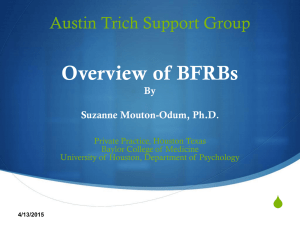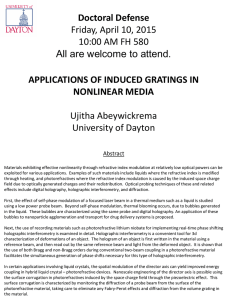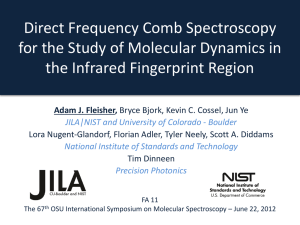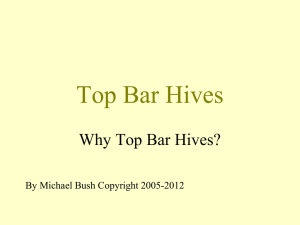spectral interferometry - Improving the Performances of Current
advertisement
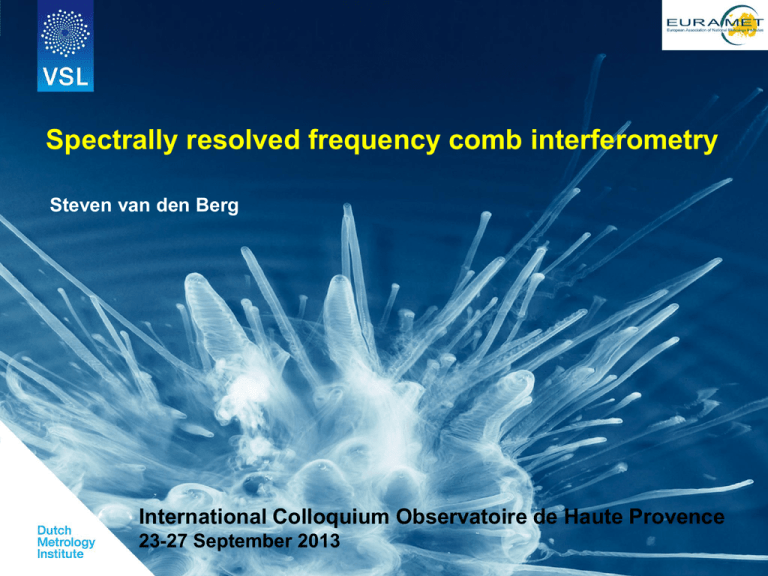
Spectrally resolved frequency comb interferometry Steven van den Berg International Colloquium Observatoire de Haute Provence 23-27 September 2013 Outline • Introduction to VSL • Introduction to the frequency comb • Distance determination based on: • cross-correlation measurement • spectral/dispersive interferometry • Proof of principle: high resolution spectral interferometry with a VIPA spectrometer • Conclusions and future prospects 2 About VSL - VSL is the national metrology institute of the Netherlands, located in Delft Private company with public task Turnover: partly government, partly market About 90 FTE ISO 17025 accredited VSL is named after Jean Henri van Swinden, who contributed to the development of the meter (end 18th century) P3 Jean Henri van Swinden Principle of the frequency comb • A frequency comb is the spectrum of a pulsed laser: 1/frep laser frep: repetition frequency f0 = f/2p • frep: offset frequentie 4 fn f0 n frep Pulsed lasers/frequency combs • Many frequencies / ‘modes’ oscillating at same time, phase locked/mode locked: L Frequency difference subsequent resonant modes: f c 2L 1 roundtrip tim e L = 15 cm f = 1 GHz 5 Pulsed lasers f fa f f a f f f a 2f f f a 3f f f a 4f And so on, for example 30 waves: 1 / f SUM 6 Properties of the frequency comb • • • • Offset frequency and repetition frequency are stabilized to an atomic clock and known on comparable level of accuracy The (vacuum) pulse-to-pulse distance is known on same level. About 10 thousand phase-locked frequencies covering the spectral range from 808-828 nm contribute to the laser output (VSL comb) Tool for direct calibration of optical frequency standards with respect to SI second (using spectral broadening in microstructured fiber) 7 Properties of the frequency comb • Properties of interest for distance measurement: – Stabilized pulse to pulse distance, acting as a ruler for distance measurement – Wide spectrum, allowing for spectral interferometry – Presence of thousands of individual and stabilized laser modes, available for homodyne interferometry 1/frep The pulse train can be viewed as a superposition of phase-locked wavelengths. 8 Why comb based distance measurement? • Absolute distance measurement with high accuracy combined with long range of nonambiguity. – Non-ambiguity range: e.g. 15 cm vs < 500 nm for single wavelength interferometry. • Prospect of very long range applications (>1000 km) due to long coherence length • Direct traceability to SI second • Potential applications – Distance measurement between satellites – Surveying applications or large scale structures – Refractive index measurement Voorbeeld voettekst 9 Application to distance measurement • Proposed/demonstrated schemes: – – – – Comb as a high frequency modulator (Minoshima) Distance measurement from cross-correlation scheme (Ye, Cui et al) Spectral/dispersive interferometry (Yoo/Kim, Cui et al) Heterodyne interferometry with slightly detuned combs (Coddington) • This talk – Distance measurement based on cross correlation – Distance measurement based on spectral interferometry – Homodyne interferometry with a mode-resolved frequency comb Voorbeeld voettekst 10 Distance measurement based on cross-correlation 1st or 2nd order correlation • Cross-correlation between pulses for path length difference equal to multiple of interpulsedistance. • Apply model pulse propagation in air • Compare to helium-neon laserinterferometer Agreement up to 50 m within 1 mm M. Cui, M.G. Zeitouny, N. Bhattacharya, S.A. van den Berg, H.P. Urbach and J.J.M. Braat, Opt. Lett. 34, No.13 (2009) Distance measurement based on spectral interferometry • Distance determined from unwrapped phase of spectral interference pattern S Eˆ 1 cos 2n L / c 2 80 mm Agreement at 50 m distance within 1 mm, uncertainty 1 mm M. Cui, M.G. Zeitouny, N. Bhattacharya, S.A. van den Berg and H.P. Urbach, Optics Express, Vol. 19 Issue 7, pp. 6549-6562 (2011). 320 mm Distance measurement based on spectral interferometry • Very good results with spectral interferometry, but with some limitations: • Applicable to restricted range because of limited resolution of the spectrometer • Calibration of wavelength scale needed by using known displacement • Ultimate goal: ability to resolve (and identify) individual comb modes • Allows for measurement of an arbitrary distance, not only close to multiples of Lpp. • No indirect calibration needed using known displacement • Not only spectral interferometry but also homodyne multiwavelength interferometry possible. 13 Unwrapping the comb • • • • Virtually imaged phase array (VIPA) to create fine angular dispersion (vertical plane) Grating for rough angular dispersion (horizontal plane) Imaging on CCD camera Stitching of vertical lines to get full frequency scale 14 Unwrapping the comb • Comb lines separated to individual dots • Repetition rate: 1 GHz • 808-828 nm dispersed in about 9000 unique dots • VIPA FSR: 50 GHz 15 ZOOM Calibration issue: which line is which? Or: how to sort dots in right order along a frequency axis • • • Use several wavelengths generated with OPO, propagating along same path as comb as markers for scale calibration Wavelength measured with wavemeter on 10-7 level simultaneously Identify set of unique dots (laser modes), that together form wavelength scale 17 Setup for distance measurement with a VIPA spectrometer • • Analyze interferometer output with a VIPA spectrometer for mode resolved spectral interferometry Short distance for proof of principle 18 Comb interference at various delays 19 Reconstructed comb spectrum • Stitching: 50 dots per vertical line and about 180 lines to get frequency scale with ~9000 comb modes Delay: 33 mm Delay: 2.5 mm 20 1) Distance determination from spectral interferometry • Distance is derived from phase change as function of wavelength • Interference • Phase • Determine L from L • with df/df determined from cosine fit through spectral interference data (equivalent to slope of unwrapped phase) • I I 1 I 2 2 I 1 I 2 cos( 2p 2L n f c d c df 4p n 2p 2 L n ) I 1 I 2 2 I 1 I 2 cos( 2p 2 L n f) c L: displacement from zero delay n: refractive index of air : wavelength f: frequency c: speed of light in vacuum NOTE: only the repetition rate is needed for distance determination so far, not the absolute frequency of each mode 21 2) Many-wavelength homodyne interferometry – – – For a certain wavelength (dot): determine phase from fitted curve Determine integer number of wavelengths from spectral interferometry Determine distance from integer number and phase, applied to known wavelength Repeat for 9000 wavelengths and average 1.0 0.5 Interference term – 0.0 -0.5 -1.0 4000 4200 4400 4600 4800 5000 frequency (position number) – Note: phase determination insensitive to intensity fluctuations 22 Comparison to counting interferometer 1.0 Interference term 0.5 0.0 -0.5 -1.0 4000 4200 4400 4600 4800 5000 frequency (position number) Interfernece term (-) 1.0 0.5 0.0 -0.5 Average difference 8 nm, Std. dev 28 nm -1.0 4000 4200 4400 4600 4800 5000 Sample no (-) 23 Discussion • • • • • • Interference pattern will repeat itself. Only multiples of Lpp/2 need to be added for longer distances A coarse measurement only needed to determine the integer number of Lpp/2, (i.e. within 15 cm), e.g. with time-of-flight, EDM. All distances can be measured, even at maximum pulse separation. Spectral interferometry and multiwavelength interferometry merged in a single scheme. Only one frequency comb needed (compared to heterodyne comb interferometry). Interferometer stability and HeNe accuracy currently limits comparison Voorbeeld voettekst 24 Conclusions • • The fs frequeny comb is powerful tool for distance measurement. Novel concept of interferometry demonstrated, based on moderesolved frequency comb. – • • Unprecedented resolution achieved with VIPA spectrometer Exploitations of thousands of comb modes allows for interferometry with huge range of non-ambiguity. An accuracy of /30 has been demonstrated, limited by interferometer stability. S.A. van den Berg, G.J.P. Kok, S.T. Persijn, M.G. Zeitouny and N. Bhattacharya, Many-wavelength interferometry with thousands of lasers for absolute distance measurement, Phys. Rev. Lett. 108 183901 (2012) 25 Follow up options • Investigation of ultimate accuracy of measurement method • Improved interferometer design (stability) • Refine data-analysis • Improvement on optical imaging? Suppression spurious reflections. • Determination of fundamental limits of many-wavelength method • Demonstration on longer distance (50 m, 600 in field targeted) • Reduce number of modes from comb with filter cavity • Allows for use of fiber-based frequency comb • Simpler spectrometer can be used Voorbeeld voettekst 26 Mode-filtering L1 f • L2 c 2L Reduce number of wavelengths with a filter cavity 27 Application to distance measurement • • • Aims to demonstrate comb-resolved distance measurement in ‘field’ conditions with a fiber laser Collaboration with TU Delft for preparation phase Field comparison at PTB baseline Voorbeeld voettekst 28 VSL team Gertjan Kok Stefan Persijn Steven van den Berg TU Delft team Morris Cui (PhD 2010) Mounir Zeitouny (PhD 2011) Nandini Bhattacharya Paul Urbach Joseph Braat • • Funding Euramet iMERA plus programme EURAMET EMRP JRP Long Distance surveying VSL PO Box 654 2600 AR Delft The Netherlands T F E I +31 15 269 15 00 +31 15 261 29 71 info@vsl.nl www.vsl.nl



